NEW DELHI: When Ajinkya Bhat traveled to Saudi Arabia, one of the most memorable views was the Edge of the World — a geological wonder in the desert northwest of Riyadh.
Located some 100 km from the capital, it is a 1,131-meter cliff at the end of the 800 km Tuwaiq Mountain range. It earned its nickname because of an uninterrupted view of the horizon from its top.
Bhat saw it first a few years ago and during his latest trip in March drove to the mountains specifically to see the landscape again.
“The first (time), I went to see the sunrise. This time, I went to see the sunset,” the 32-year-old from Pune told Arab News.
“Saudi has lots of raw natural landscapes … really good beaches. East coast, west coast, center — they have lots of different things. Tourists can go and check it out.”
But it was not just the landscape that drew him to the Kingdom. Bhat’s first trip was about the Formula E championships, which Saudi Arabia has been hosting since 2018, making nature, adventure, and a tad of luxury some of his main criteria for a good trip.
“It’s a good place for vacation … Saudi ticks all the boxes,” he said. “You don’t have to go to Europe and the US.”
Bhat is among an increasing number of wealthier Indian travelers below the age of 35 choosing the Middle East as their destination for a foreign trip, with Saudi Arabia and the UAE taking the lion’s share of those choices.
Saloni Aneja, a 29-year-old from Chandigarh, visited the UAE in January and said she found everything she needed on her vacation.
“You have adventure, water parks and a lot of shopping complexes and different things … You have a lot of things to see, for example, the Museum of the Future. It’s a great thing,” she told Arab News, as she was already planning her next trips.
“Nowadays, the young generation, the youth, believe that we should travel the world, we should not just save the money and keep it in the locker, we should travel and explore,” Aneja said.
“I would definitely like to explore different parts of the world … I would love to visit Saudi Arabia.”
The “Future of Travel” report on the spending trends of India’s young globetrotters released last month by the marketing agency FINN Partners shows that travelers were increasingly choosing the two Gulf countries over others.
“The Middle East region as a whole really continues to excite and capture very young Indian travelers with a blend of luxury and rich history,” Thomas Morris, the agency’s senior partner, told Arab News. “We found that 55 percent of Indians under 35 have already visited the UAE. For Saudi Arabia, it was 45 percent.”
The respondents were under 35 years old, living in big Indian cities, had “the propensities to travel internationally,” and the means to do so.
“One of the key findings is the willingness of young Indian travelers to spend on what we term a once-in-a-lifetime experience. So, 42 percent indicated they’re willing to pay more for these experiences,” Morris said.
“When we look specifically at the UAE and Saudi Arabia, we see that they are particularly drawn to firstly luxury and secondly adventure sports — being in the deserts of the UAE or ziplining or going and trekking in AlUla and Saudi Arabia.”
According to his observations, these qualities made the young travelers different from the previous generation, who prefer to plan their trips with all details and in advance.
“The next generation, they are impulsive, they are willing to jump on opportunities as they arise, and I think this is something that the UAE and Saudi really tapped into — these kinds of international micro-adventures,” he said, adding that in the case of Saudi Arabia, what also helps attract younger Indians is the current marketing strategy, which is drawing more and more visitors from India.
With a series of initiatives last year, including the sponsorship of the Indian Premier League — the men’s T20 franchise that is the world’s most-watched cricket league — Saudi Arabia hosted over 1.5 million Indian inbound travelers in 2023, or 50 percent more than in 2022.
By 2030, the Saudi Tourism Authority plans to welcome 7.5 million visitors from India, which by that time is expected to emerge as the No. 1 inbound tourist market for the Kingdom.
“This new generation are digitally savvy, they are making a lot of decisions based on what they see on social media, and Saudi Arabia is really successfully tapping into that,” Morris said.
“They want to be the focus destination for Indian travelers, and they are investing significantly for that to happen.”
Jatin Kumar, a 32-year-old from Haryana, visited Saudi Arabia in March.
“Saudi Arabia is developing now and bringing more tourists, building attractive things,” he said.
“I went to Riyadh, I went to Jeddah, I went to Dammam … We got to know a lot of Saudi culture … I really liked it.”






























